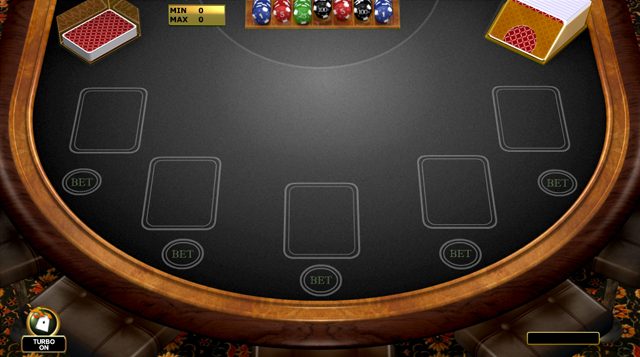
How to Play Classic BlackJack
Short Description:
In the Classic Blackjack game you are competing against the dealer (the house).
The player and the dealer are each dealt two cards, with the goal of reaching 21, without going over. The player may draw as many cards as he wishes, until reaching 21. If the player draws a card that puts him over 21 (which is called a “Bust”), he loses the hand. A winning hand adds up to more than the dealer’s hand, without “Busting”.
Classic Blackjack Rules
Our Classic Blackjack game has a dealer and a player. The dealer deals from 6 decks of playing cards which are shuffled after every round. Before the cards are dealt, the player should first choose his position and then place his bets by clicking on either the 1 chip, 5 chip, 25 chip or the 100 chip, to reach the desired bet. After deciding on the desired bet, the player must click the “Deal” button in order to proceed with the hand. The round begins after the player has bet and clicked “Deal”.
A player may play multiple hands at one time.
Once the deal begins the bets may not be changed. During the course of the hand, the player may add to his bets through the options of Double Downs, Splits, and Insurance. After the cards are dealt, the player may choose the option that will yield him more opportunities. Buttons, located on the lower center of the screen, will appear in order to facilitate the player’s decision. For example, if it is possible to split two cards, a button will appear to allow the player to split the cards. The player will then simply need to click on the “Split” button.
The player receives two cards face up, and the dealer receives one card, face up. If the dealer’s up card is an ace, the player has the option of making an “Insurance Bet” after which the dealer checks the other card for Blackjack. If the dealer has a Blackjack, the hand is over. If a player also has blackjack the result is a push. In all other cases, the game continues, and the player may request as many additional cards as desired, until he chooses to “Stand” or “Bust”. If a player gets a Blackjack, which is a 10 or a face card along with an Ace, he is immediately paid 1.5 times the placed bet, unless the dealer also has Blackjack, in which case it is a “Push” (the player’s bet is left on the table).
Only a 10 or a face card along with an Ace is considered a Blackjack and overcomes a 21 hand.
After all of the player’s bets have been completed, the dealer completes his hand. If the dealer has sixteen or less, he must draw a card (Hit), until he reaches at least seventeen. If the dealer’s card total exceeds 21 (Bust), he must pay all remaining hands in the game.
An Ace can be valued as either a 1 or an 11. Face cards such as the King, Queen and Jack are valued at 10. All other cards are valued at their face value.
A “Hard Hand” is a hand with no ace, or a hand with an ace valued as 1. A hand comprised of an Ace, 7, and 9 is called a “Hard 17″.
A “Soft Hand” is a hand with an ace valued as 11. A hand comprised of an Ace and a 6 is called a “Soft 17″. The dealer will stand on a soft 17.
“Double Down”: A player may select the “Double” option after being dealt two cards. The Double option automatically doubles the player’s bet and deals one additional card, face up. The player cannot draw any additional cards. The player may double down on any first two cards dealt or after splitting a pair.
“Split”: If the player is dealt any pair of cards, on the first two cards (i.e., two Fives, two Jacks, etc.), he may split the cards into two separate hands. A split may occur on hands where the first two cards have the same value as well as on identical cards. The split option automatically places an additional bet, equal to the original wager. Each hand is then played independently, and the player may request as many Hits as desired on each hand (with the exception of Aces, which receive only one additional card per hand). In the case of split Aces or Tens, a player’s Blackjack is not possible and is considered as a regular 21. In this case, a dealer’s Blackjack wins, and a dealer’s 21 becomes a “Push”. If the dealer’s first card is a 10 or face card, and the concealed card is an Ace, the dealer’s Blackjack wins and the player loses their initial and secondary bets.
There is no possibility to re-split hands in this game.
“Insurance”: If the dealer has an Ace, the player has the option of making an “Insurance Bet”. The Insurance equals half the original bet, and ensures that the player will not lose their wager should the dealer be concealing a 10 or face card under their Ace. If, in fact, the dealer’s down card is equal to 10, the player wins double the Insurance Bet. If, instead, the dealer’s down card has a value of less than 10, the player loses the Insurance Bet and continues normally with the hand.
“Even Money”: If the dealer has an Ace, and the player has a Blackjack, the player has the option of “Even Money”. By choosing this option, the player will receive the same amount (1 to 1) of his Blackjack, without the Dealers face-down card even being exposed, thus protecting himself from a possible Dealer’s Blackjack. The player may also choose to continue playing without using the “Even Money” option. If the Dealer does not have a blackjack, the player will be paid at a normal relation of 3 to 2 on his Blackjack.
“Push”: A Push refers to when the dealer and the player have the same numerical count in their hands. In this case, the play is a draw, and the players’ bets remain on the table.
Payoff
|
Result |
Payoff |
| Winning Hand | 1 to 1 |
| BlackJack | 3 to 2 |
| Insurance | 2 to 1 |
NOTE: Malfunction voids all pays and plays.
Minimum and Maximum betting limits
Minimum bet: 1 USD
Maximum bet: 300 USD
Premium Classic Blackjack
The premium version of this game has the same rules and functions.
The table color is black and the betting limits are higher:
Minimum bet: 5 USD
Maximum bet: 2000 USD
The theoretical expected return to player for this game is 99.52%





















